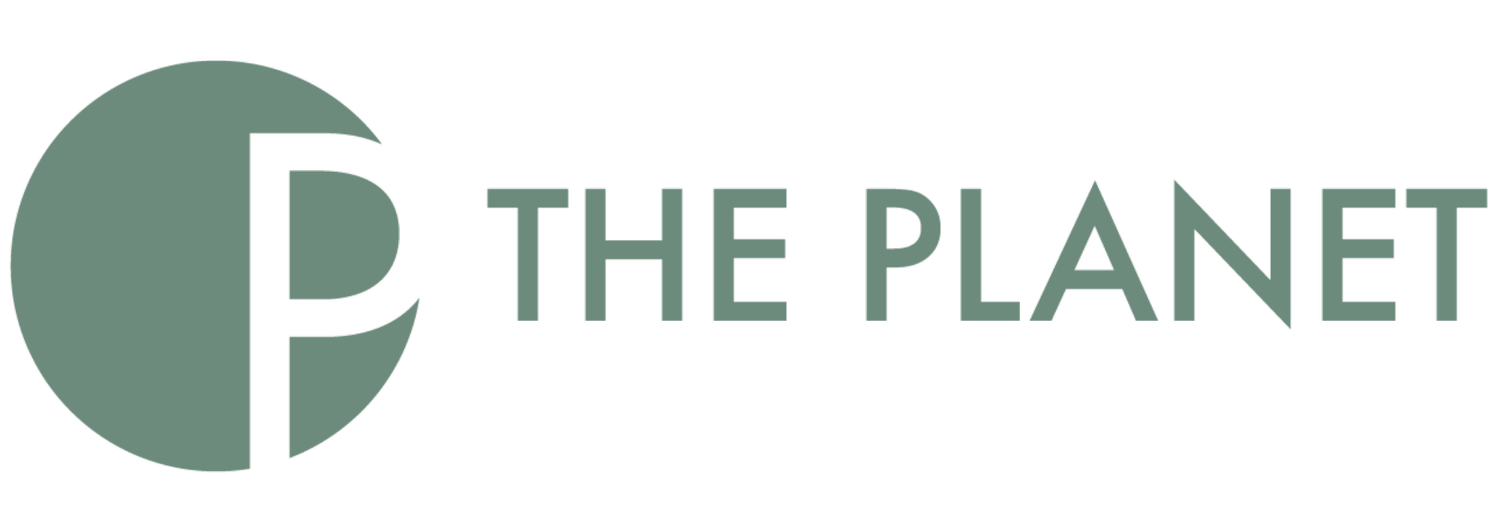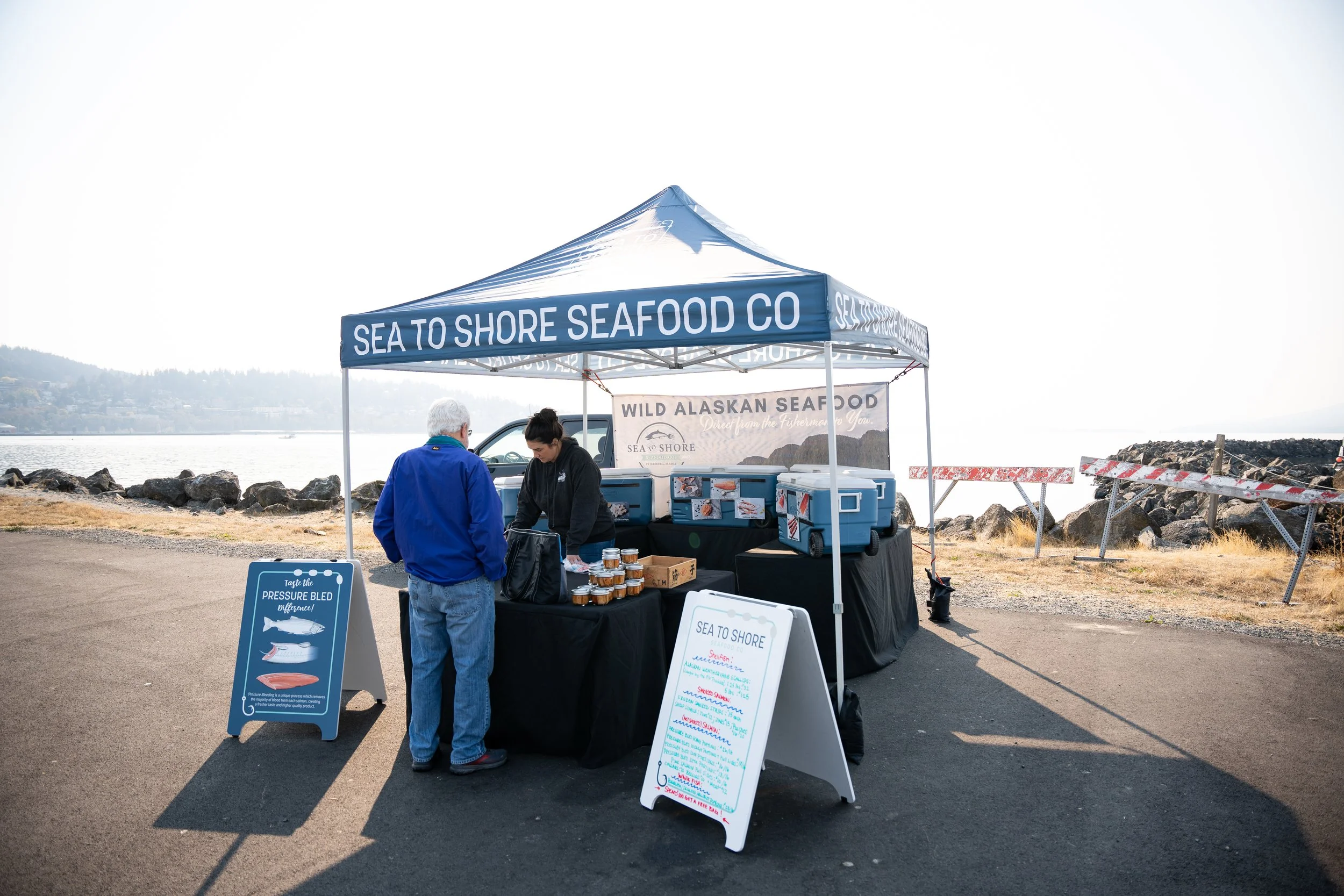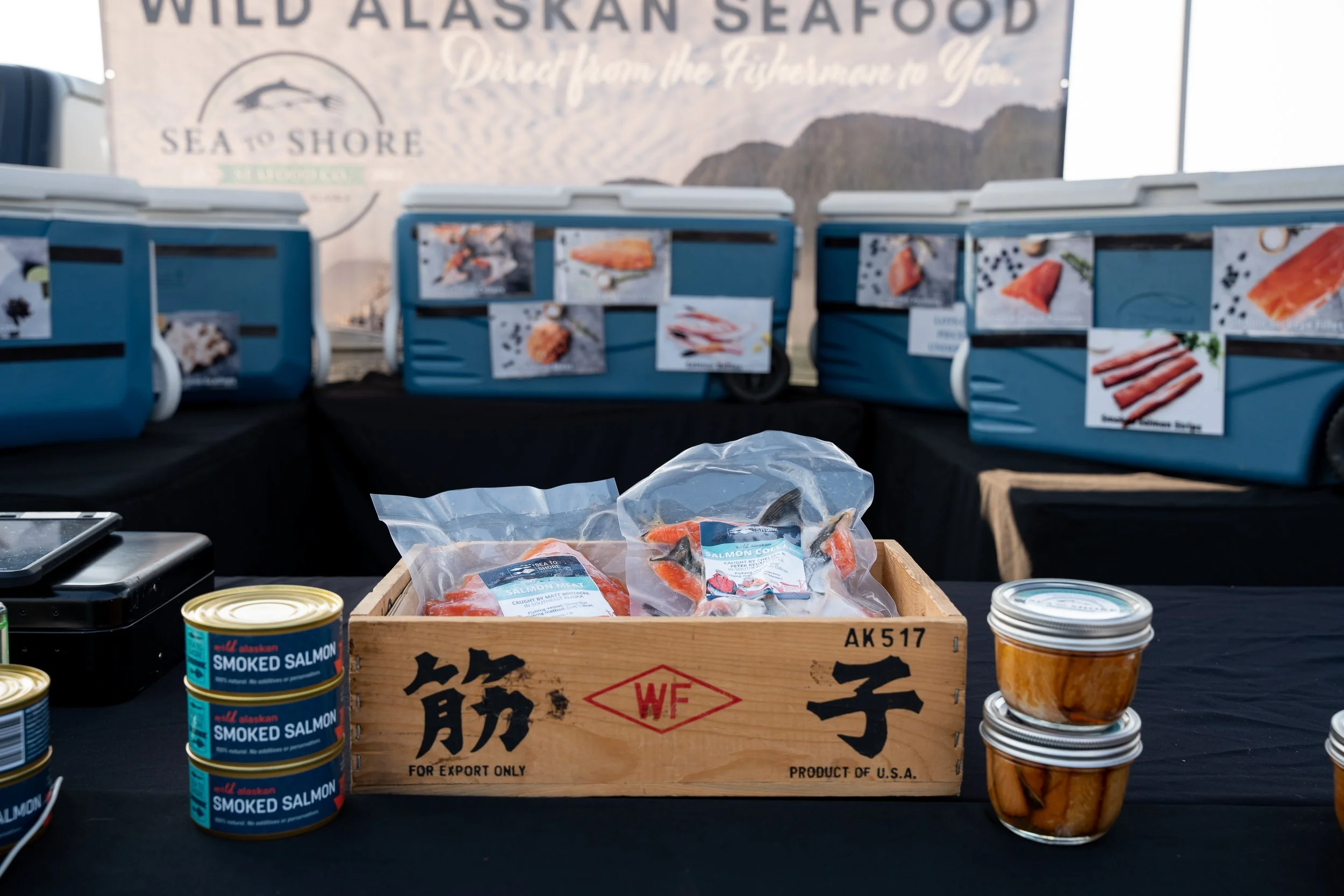Dockside to Tabletop
Bellingham’s Dockside Market brings community, business and fish together in a sound and sustainable way.
Story by Janine Fong
Photos by Nick Lavinder
December 8, 2022
Clusters of people arrive at Gate 5 in Squalicum Harbor on a sunny Saturday morning in October, breathing in a playful salted breeze. A handful of tents encircle an asphalt clearing that overlooks the glittering waters of Bellingham Bay. Visitors pause at the directory to read the products of the day on a large whiteboard and receive directions to even more vendors on the pier itself.
The Lummi Seafood Market attracts several customers with salmon and fresh sea urchin. Sea to Shore Seafood sells a range of salmon products, halibut and scallops. Icy Fresh Seafood sells bags of sweet frozen shrimp. This is Bellingham’s Dockside Market.
Co-owner of Sea to Shore Seafood, Chelsea Keutmann, sells frozen salmon meat to a customer.
The Dockside Market (Dockside) is an example of direct seafood marketing, a practice that has developed in response to the rise in popularity of buying locally. By purchasing seafood in this manner, customers achieve clarity in the source of their food and support a community of individuals who care deeply about the state of our oceans.
Direct seafood marketing encompasses a variety of techniques, from fish markets to community-supported fisheries which regularly deliver their products to customers who pay a membership fee. Although wild-caught seafood has its own issues, its impact pales in comparison to the land and freshwater consumption of the U.S. agriculture industry. Supporting small-scale fishers and boats minimizes the environmental impacts even further by cutting down on the fuel needed to transport food over long distances.
Chelsea Keutmann, co-owner of Sea to Shore Seafoods, truly values the educational capabilities of this direct relationship. From her tent, Keutmann sells flash-frozen salmon meat, fillets, collars, bellies and more. Each package bears the name of the boat or the smiling faces of the fishers who caught that fish. Keutmann is also happy to answer any questions, from the origin of the fish to the processing methods used.
“When someone says something is sustainable, ask them how it was caught. When they say it’s traceable, ask them where it’s from. Ask if they can show you or tell you how they apply their practices to be sustainable,” said Keutmann. “Education and exposure to the methods is really what’s gonna help bring a change in the way we consume.”
Fishers like Keutmann and her husband, who prioritize minimizing waste and practicing sound, explainable methods, are putting the future first. Sustainability can be a vague word, so what does it mean for seafood? In truth, it comes with a variety of definitions, especially where fisheries are concerned.
According to Daniel Armellino, a fish biologist with the National Marine Fisheries Service, “sustainability” in management is upheld by four pillars. In essence, these four pillars are: stable fish populations, preservation of human health and knowledge, protection of culture and community and maintenance of livelihoods. Dockside’s fishers hold these values in high regard, especially since recent events have disrupted the Bellingham marine community.
As far as economic stability, the COVID-19 pandemic threatened many fishing communities, especially those of tribal fishers. Tribal fishers struggled amidst pandemic restrictions and poor economic demand, with limited assistance from state relief packages. Many state plans failed to integrate the required protections for tribal fisheries, despite the promise of relief funding from the federal Coronavirus Aid, Relief, and Economic Security (CARES) Act, according to a review from the University of Waterloo. Going forward, there is a need for increased advocacy for consistent recognition of Tribal maritime rights and authority. Supporting tribal fishers is an integral part of helping to strengthen this community.
The Lummi Seafood Market, owned by Terry Phair, carries many unique products such as sea urchin, sea cucumber and geoduck. For them, Dockside is sustainable, not only for seafood, but for the fishing community at large. Their tent is always alive with activity, as various members of Phair’s family serve customers, weigh products and share advice about their favorite ways to enjoy sea urchin or salmon. As Phair finished his interview, he looked back at where his family was waiting for him and added one last statement.
Owner of Lummi Seafood Market, Terry Phair, poses with his son, Sky, over fresh green sea urchin.
“Me, my son, my little son, my lady, my niece, my workers, this all stems from seafood. And this is our only income,” said Phair. “We've got to figure out ways that we can stay sustainable, not just as fishermen, but as people.”
Dockside is recognized by the Local Catch Network, a web of fishers committed to increasing the visibility and profitability of regional seafood systems and community-based fisheries. This means that Dockside is aligned with a number of core values, such as gratitude to Indigenous peoples, sustainable practices that prioritize the environment and general education about seafood and fishing. The efforts of numerous people, ranging from regional fishers to theWhatcom County Department of Health, came together for the success of the market.
During the uncertain time of the COVID-19 pandemic, Dockside was run by the Bellingham SeaFeast in lieu of SeaFeast itself. The SeaFeast is an annual celebration of the Bellingham maritime culture and heritage that allows everyone to enjoy seafood and learn about the waterfront industry. But, as the pandemic lightened, SeaFeast began to prepare for its return, and the market needed to be managed by someone else. The Port of Bellingham’s community outreach department adopted management of the market.
“I think a lot of people are trying new things and realizing that they like more than they realized,” said Dockside Market Coordinator, Cari Chan. “So, I think it’s a great opportunity to know what we have in our waters in Washington and in our Sound here.”
Sea to Shore Seafood displays frozen salmon meat as well as jars and tins of smoked salmon. The coolers in the back contain frozen scallops, halibut portions, salmon fillets, collars, and bellies.
Dockside is only one example of how communities can come together to support their local fishing industries and make healthier choices for the world’s oceans. Along the West Coast, a non-profit trade organization called Positively Groundfish is working to increase awareness of local, lesser-known fish species and the efforts of science-based management systems.
On a global scale, organizations such as the Marine Stewardship Council work to recognize and reward fisheries that are sustaining resources and livelihoods for generations. Large companies are making the shift toward sound sources of seafood in response to pressure from consumers and environmental groups, according to Brian Halweil, a researcher at WorldWatch Institute.
All this work toward protecting the oceans culminates in the choices made by consumers. At Dockside, direct connections are being forged encouraging people to purchase seafood from family-owned businesses who hold a deep love for the ocean.
For many of the vendors, such as with Icy Fresh Seafoods, fishing is an intergenerational practice. Their ship is captained by Bill Armstrong who approached the Dockside at its beginning, eager to get involved. Now, his daughter, Heather Kaminsky, sells shrimp at the market and brings her own children on fishing trips to continue the family business.
“You can fish for a large company, or you can fish for yourself. And there’s a lot of risk in fishing for yourself,” said Kaminsky. “But then you also get the integrity of being the fisherman. And I think fishermen have some of the highest integrity out there.”
Janine Fong is an environmental science student and a member of Western's honors program. She enjoys studying the complex management of common resources such as fish, water, and land.



